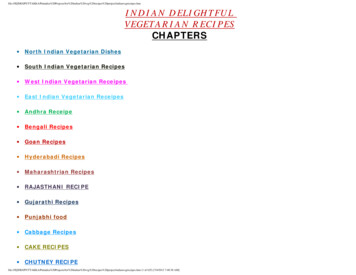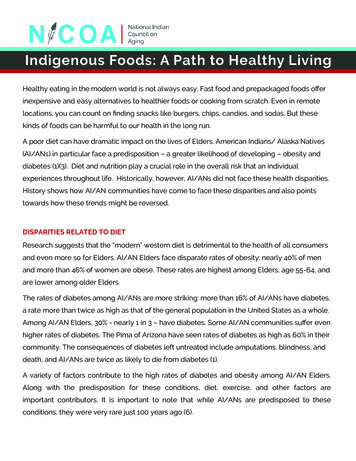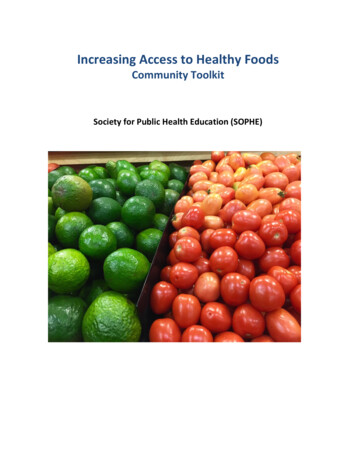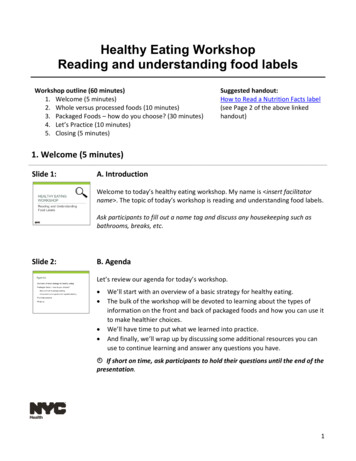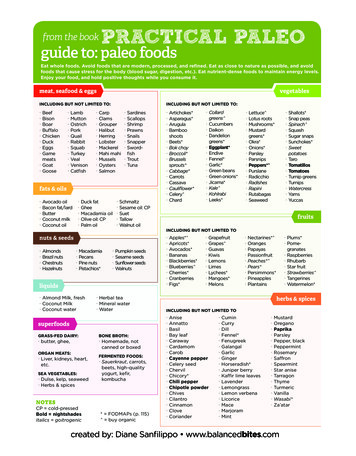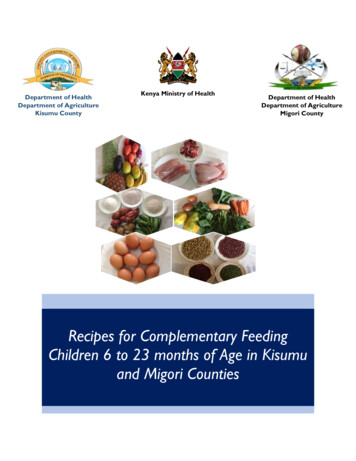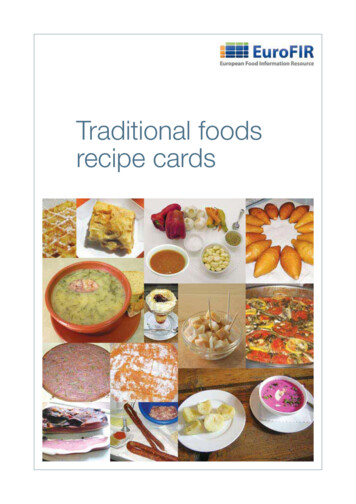
Transcription
Traditional foodsrecipe cards
Traditional Foods Recipe CardsEuroFIR Traditional Foods Recipe CardsThese traditional foods recipe cards were produced aspart of the traditional foods work package of the EuroFIR(European Food Information Resource) Network ofExcellence.There are many different cultures within Europe, each withtheir own, distinct dietary habits. Traditional foods arekey elements in the dietary patterns of each country, butunfortunately, in most countries there is little informationon the nutritional composition of such foods. Therefore,there is a real need to study traditional foods to preservethese elements of European culture and, if possible, enrichand improve dietary habits across the whole continent.The Traditional Foods work package in EuroFIR hasbrought together new information on the culinary history,ingredients, preparation and nutritional composition oftraditional recipes from 13 European countries (Austria,Belgium, Bulgaria, Denmark, Germany, Greece, Iceland,Italy, Lithuania, Poland, Portugal, Spain and Turkey).These recipes are presented in this resource and it ishoped that they will provide an informative and interestingreference for those interested in traditional foods all overthe world.The cards were produced by the work package leader,Dr Helena Soares Costa, National Institute of Health(INSA), Portugal, in collaboration with Bridget Benelam atThe British Nutrition Foundation, UK. The work packageleader would like to thank all colleagues from the EuroFIRconsortium’s traditional foods work package who haveprovided information and helped to review the cards, withspecial thanks to Prof. Antonia Trichopoulou, Vardis Dilisand Effie Vasilopoulou from the National and KapodistrianUniversity of Athens.The partners in the traditional foods work packageinclude:NNNNNNNNUniversity of Vienna (UVI)/Graz Universityof Technology (GUT), AustriaGhent University (RUG), BelgiumNational Centre of Public Health Protection(NCPHP), BulgariaNational Food Institute, Technical Universityof Denmark (DTU), DenmarkThe Federal Research Centre for Nutrition and Food(BFEL), GermanyDepartment of Hygiene and Epidemiology, MedicalSchool, University of Athens (NKUA), GreeceMatis ohs (MATIS), IcelandNational Institute for Food and Nutrition Research(INRAN)/Centro per lo Studio e la PrevenzioneOncologia (CSPO), ItalyNNational Nutrition Centre (NNC), LithuaniaNNational Food and Nutrition Institute (NFNI), PolandNNational Institute of Health (INSA), PortugalNNCentre for Superior Studies on Nutritionand Dietetics (CESNID)/University of Granada(UGR), SpainTubitak Marmara Research Centre (TUBITAK), TurkeyThis work was completed on behalf of the EuroFIR Consortium and funded under the EU 6th Framework FoodQuality and Safety Programme. Project number (FP6-513944).
Traditional Foods Recipe CardsContentsAustriaItalyVegetable Soup: GemüsesuppeCabbage Noodles: KrautfleckerlPotato Dumplings: KartoffelknödelViennese Schnitzel: Wiener SchnitzelApple Strudel: ApfelstrudelVicentina Cod: Bacala’ alla VicentinaBraised Beef with Barolo Wine: Brasato al BaroloPizza Napoletana Margherita: Pizza NapoletanaMargheritaTuscan Castagnaccio: Castagnaccio ToscanoRicotta Stuffed Roll: Cannoli SicilianiBelgiumShrimp Croquette: GarnaalkroketFlemish stew: Vlaamse stoofkarbonadenGratin of Belgian endives with ham and cheese sauce:Witloof met ham en kaassausMeatballs: Vleesballetjes (frikadellen)Waffles: WafelsBulgariaTarator (Cold soup): Студена супа “Таратор”Veal ‘Priest’s’ stew: Телешко “Попска яхния”Pepper relish: ЛютеницаNettles with rice: Коприва с оризPumpkin pastry: Сладкиш с тикваDenmarkHamburger Steak: HakkebøfFried Plaice: Stegt rødspætteApple Charlotte: ÆblekageGermanyPumpernickel Bread: Pumpernickel BrotSwabian Ravioli: Schwäbische MaultaschenBlack Forest smoked ham: Schwarzwälder SchinkenThuringian Sausages: Thüringer RostbratwurstDresden fruit loaf: Dresdner StollenGreeceGreek Traditional Chickpea Soup: ΕλληνικάΠαραδοσιακά Ρεβίθια ΣούπαGreek Traditional Rabbit Stew: Ελληνικό ΠαραδοσιακόΚουνέλι ΣτιφάδοGreek Traditional Leek Sausages: ΕλληνικάΠαραδοσιακά Λουκάνικα με πράσοGreek Traditional Must-jelly: Ελληνική andCured Shark: Kæstur hákarlStockfish, haddock: Harðfiskur, hert ýsaSmoked Lamb: HangikjötPickled Blood Sausage: Súrsaður blóðmörSkyr: SkyrLithuaniaCold Fresh Beetroot Soup: ŠaltibarščiaiCheese ‘Dziugas’: Sūris „Džiugas“Boiled Banger (Country-Style Sausages): KaimiškosDešrelės,Zepplins with Meat: Cepelinai Su Mėsa („Didžkukuliai“)Lithuanian Biscuits – ‘Twigs’ (Zagareliai): ŽagarėliaiPolandCold Soup: Chłodnik litewskiSmoked Ewe’s Milk Cheese: OscypekDish made of sauerkraut, meat and dried mushrooms:BigosPork Chop: Kotlet schabowyTree Cake: SękaczPortugalGreen Kale Soup: Caldo VerdeCodfish with Chickpeas: Bacalhau com grãoGoat kid roasted in a wood fired oven: Cabrito assadono fornoPortuguese boiled dinner: Cozido à portuguesaEgg Sweet from Murça: Toucinho de céu de MurçaSpainHot vegetable sauce: Mojo picónGalician Octopus: Pulpo a la Gallega “a feira”Roasted Pepper & Aubergine Salad: Escalivada:Ensalada de Pimientos y Berenjenas AsadasCardoon in Almond Sauce: Cardos en Salsa deAlmendrasAlmond cake: SoplillosTurkeyTarhana Soup: Tarhana UŒakPastirma: Pastırma (Kayseri)Kebab with yoghurt: Kebap, yoœurtluHamsi Anchovy: Hamsi BuœulamaBaklava: Baklava GaziantepThis work was completed on behalf of the EuroFIR Consortium and funded under the EU 6th Framework FoodQuality and Safety Programme. Project number (FP6-513944).
EuroFIR Project Management Office/British Nutrition Foundation 2009.No part of this publication may be reproduced without prior writtenpermission from the EuroFIR Project Management Office,Institute of Food Research, Norwich Research Park,Norwich, Norfolk, NR4 7UA, UK.
AustriaTraditional foods recipe cardsVegetable Soup(Gemüsesuppe)Provides 4 servings. Preparation time is 40 minutes.This traditional Austrian Vegetable soup is not onlysavoury and healthy but also relatively cheap and easy toprepare. In contrast to other classical vegetable soups likeminestrone from Italy, Austrian vegetable soup containsflour and is therefore filling and warming in winter. Theingredients are very varied depending on the recipe.Typically they are a combination of root vegetables likecarrots and celery, cabbage types like cauliflower andBrussels sprouts, pulses like peas as well as onionand leek.Nutritional information per 100g of edible portionEnergy (kcal / kJ)400 / 1697Protein (g) (N x 6.25)1.4Total Fat (g)of which saturated fatty acids (g)1.30.8Carbohydrates (g)of which sugars (g)95.62.4Dietary fibre (g)1.75Sodium (mg)99.8Values obtained from laboratory analysesIngredients1.5L Water200g Cauliflower100g Brussels sprouts70g Carrots30g Celery90g Leek100g Green beans1.8g Salt20g Yellow carrot2 Vegetable stock cubes3g Chopped parsley30g Butter30g FlourPreparationClean and peel the vegetables. Chop the cauliflower,Brussels sprouts, cube the green beans, carrots andcelery and slice the leeks. Add the water to a pot and bringto the boil. Add the salt, the stock and the vegetableswhich take longest to cook. Then add all the remainingvegetables including the chopped parsley. Cook for about30 minutes then remove the vegetables from the pot butleave the soup. Heat the butter in a separate pan, thenadd the flour and heat the roux until it is light brown. Addthe vegetables and the roux to the soup and cook for afurther 5 minutes.For more information on Austrian traditional foods contact the University of Vienna www.univie.ac.ator the Graz institute of technology www.ilct.tugraz.atThis work was completed on behalf of the EuroFIR Consortium and funded under the EU 6th Framework FoodQuality and Safety Programme. Project number (FP6-513944).
ÖsterreichRezeptkarten für traditionelle GerichteGemüsesuppeMengenangaben sind gegeben für 4 Portionen.Zubereitungsdauer beträgt 30 Minuten.Die traditionelle österreichische Gemüsesuppe ist nichtnur schmackhaft und gesund, sondern auch nochrecht günstig und einfach in der Zubereitung. Da sie imGegensatz zu klassischen Gemüsesuppen aus anderenLändern wie z. B. der Minestrone aus Italien mit Mehlgebunden wird, ist sie sehr sättigend und dient vor allemin den Wintermonaten als Wärmespender von innen. DieZutaten sind je nach Rezept unterschiedlich, typisch isteine vielfältige Zusammenstellung von Wurzelgemüsenwie Karotten und Sellerie, Kohlarten wie Karfiol undKohlsprossen, Hülsenfrüchte wie Erbsen sowie Zwiebelnund Lauch.Nährwertangaben pro 100g verzehrbarer MengeEnergie (kcal / kJ)400 / 1697Protein (g) (N x 6.25)1.4Gesamtfett (g)davon gesättigte Fettsäuren (g)1.30.8Kohlenhydrate (g)davon Zucker (g)95.62.4Ballaststoffe (g)1.75Natrium (mg)99.8Zutaten1.5L Wasser200g Karfiolröschen100g Kohlsprossen70g Karotten80g Sellerie80g Lauch20g gelbe Rüben100g Zuckererbsen1.8g Salz11.67g SuppenwürzePetersilie gehackt30g Butter30g MehlZubereitungDas Gemüse reinigen und nach Bedarf schälen.Kohlsprossen und Karfiolröschen teilen, Zuckererbsen,Karotten, Kartoffel und Sellerie in Würfel schneiden, Lauchin Streifen schneiden, Wasser salzen und Suppenwürzehinzugeben. Sobald das Wasser kocht, die Gemüseartenje nachdem, ob sie kürzer oder längere Zeit zumWeichwerden benötigen, zugeben und kochen lassen.Fett erhitzen, Mehl beigeben und anschwitzen.Die Gemüsesuppe abseihen, damit die Einmach aufgießen,glatt rühren. 5 min kochen lassen. Gemüse wiederbeigeben, mit Kräutern und Gewürzen kombinieren.Werte aus LaboranalysenFür mehr Informationen zu österreichischen traditionellen Gerichten kontaktieren Sie bitte das Institutfür Ernährungswissenschaften der Universität Wien oder das Institut für Lebensmittelchemie und –technologie der Technischen Universität Graz.Diese Arbeit wurde im Namen des EuroFIR Konsortiums erstellt und durch das 6. EU RahmenprogrammsLebensmittelqualität und -sicherheit finanziert (Projektnummer FP6-513944).
AustriaTraditional foods recipe cardsCabbage Noodles(Krautfleckerl)Provides 4 servings. Preparation time is one hour.The first recipes for Cabbage Noodles appear in Austriancookery books in the last third of the 19th Century. Thedish originally derives from the every-day cuisine fromAustria and Bohemia. Nowadays Cabbage Noodles are apart of the traditional Viennese cuisine.Nutritional information per 100g of edible portionEnergy (kcal / kJ)414 / 1754Protein (g) (N x 6.25)4.2Total Fat (g)of which saturated fatty acids (g)4.40.8Carbohydrates (g)of which sugars (g)89.46.1Dietary fibre (g)2.0Sodium (mg)140Values obtained from laboratory analysesIngredients60g Oil50g Bacon rashers1 Teaspoon sugar0.5kg Cabbage1 Onion½ Teaspoon salt150g NoodlesA pinch of pepper1 Teaspoon caraway125ml of white winePreparationWash the cabbage, shred it finely and then blanch it.Chop the onion into small pieces and fry in a pan with thesugar and oil. Add the cabbage to the onion, togetherwith some salt, pepper, wine and caraway, and steamuntil the cabbage softens.In another pan fry the rashers of bacon. Soft boil thenoodles, add in with the cabbage, and warm for a coupleof minutes in the oven. Then add the bacon.For more information on Austrian traditional foods contact the University of Vienna www.univie.ac.ator the Graz institute of technology www.ilct.tugraz.atThis work was completed on behalf of the EuroFIR Consortium and funded under the EU 6th Framework FoodQuality and Safety Programme. Project number (FP6-513944).
ÖsterreichRezeptkarten für traditionelle GerichteKrautfleckerlMengenangaben sind gegeben für 4 Portionen.Zubereitungsdauer beträgt 1 erreichischen Kochbüchern erst im letzten Drittel des19. Jahrhunderts auf. Das ursprünglich aus der einfachenBauernküche von Österreich und Böhmen stammendeGericht gehört heute zu den Klassikern der WienerKüche.Zutaten60g Pflanzenöl50g Speck vom Schweinebauch1 TL Zucker0,5kg Kraut1 Zwiebel½ Teelöffel Salz150g Fleckerl (Eiernudeln)PfefferKümmel125ml WeißweinNährwertangaben pro 100g verzehrbarer MengeEnergie (kcal / kJ)414 / 1754Protein (g) (N x 6.25)4.2Gesamtfett (g)davon gesättigte Fettsäuren (g)4.40.8Kohlenhydrate (g)davon Zucker (g)89.46.1Ballaststoffe (g)2.0Natrium (mg)140ZubereitungKraut fein schneiden, waschen, abbrühen und abseihen.Zwiebeln und Zucker in Fett bräunlich rösten, das Krauthinzugeben, Wein übergießen, würzen und dünsten bisdas Kraut weich ist.Die gekochten Fleckerln untermischen, das Ganze kurz imRohr ziehen lassen und zerlassenen Speck unterrühren.Werte aus LaboranalysenFür mehr Informationen zu österreichischen traditionellen Gerichten kontaktieren Sie bitte das Institutfür Ernährungswissenschaften der Universität Wien oder das Institut für Lebensmittelchemie und –technologie der Technischen Universität Graz.Diese Arbeit wurde im Namen des EuroFIR Konsortiums erstellt und durch das 6. EU RahmenprogrammsLebensmittelqualität und -sicherheit finanziert (Projektnummer FP6-513944).
AustriaTraditional foods recipe cardsPotato Dumplings(Kartoffelknödel)Provides 6 servings. Preparation time is 1 hour and45 minutes.Very similar to the cuisine of bordering Bohemia, LowerAustria is famous for its dumplings. They are made ofplain dough (flour, breadcrumb, or potato based) andare common side dishes to meat- or vegetable-baseddishes.Nutritional information per 100g of edible portionEnergy (kcal / kJ)Protein (g) (N x 6.25)Total Fat (g)of which saturated fatty acids (g)Carbohydrates (g)of which sugars (g)105 / 4471.80.1Trace24.33.7Dietary fibre (g)2.4Sodium (mg)525Values obtained from laboratory analysesIngredients2kg Potatoes (floury)5g Salt5g Wheat flour to sprinkle on worktop and hands to helpto shape the dumplingsPreparationBoil half the potatoes (unpeeled) in water. Once cooked,peel and grate them. Peel the remaining potatoes, thensulphurise them for at least 30 minutes in a hermeticallysealed pot (this is done to avoid the dumplings becominggreyish/black after cooking). Then wash the sulphurisedpotatoes with tap water and grate them with a cheesegrater. Put the grated potatoes into a strainer bag andsqueeze them to drain and collect the liquid (whichcontains the starch). The liquid should rest for 10 to 15minutes until the starch has separated out. After this,drain the water and collect the starch with a spoon andmix with the cooked and pressed potatoes and with theraw and grated potatoes and salt. Mix all the ingredientsand knead until they form a smooth dough. Shape thedumplings by hand and boil in water for about 20–25minutes.For more information on Austrian traditional foods contact the University of Vienna www.univie.ac.ator the Graz institute of technology www.ilct.tugraz.atThis work was completed on behalf of the EuroFIR Consortium and funded under the EU 6th Framework FoodQuality and Safety Programme. Project number (FP6-513944).
ÖsterreichRezeptkarten für traditionelle GerichteKartoffelknödelDie Mengenangaben beziehen sich auf 6 Portionen.Zubereitungszeit beträgt ca. 1 Stunde und 45 Minuten.Ähnlich wie das benachbarte Böhmen, ist Niederösterreichfür das reichliche Angebot an Knödel bekannt. Diesewerden aus einem einfachen Teig zubereitet (Mehl,alte Semmel oder Kartoffel) und werden als Beilage zuGemüse- oder Fleischgerichten serviert.Nährwertangaben pro 100g verzehrbarer MengeEnergie (kcal / kJ)Protein (g) (N x 6.25)Gesamtfett (g)davon gesättigte Fettsäuren (g)Kohlenhydrate (g)davon Zucker (g)105 / 4471.80.1Trace24.33.7Ballaststoffe (g)2.4Natrium (mg)525Zutaten2kg Mehlige Kartoffel5g Salz5g Weizenmehl (480) für Arbeitsfläche und Hände, umdas Formen der Knödel zu erleichternZubereitungEtwa die Hälfte der Kartoffeln wird in Wasser weichgekocht (ungeschält). Die gekochten Kartoffeln werdensofort geschält und mit einer Kartoffelpresse zerkleinert.Die andere Hälfte wird roh geschält und für ca. 30 Minutengeschwefelt (mit einem Schwefelblatt in einem gutschließenden Topf). Anschließend werden die Kartoffelngewaschen und fein gerieben. Die geriebenen Kartoffelnwerden durch ein feinmaschiges Sieb gepresst und dieFlüssigkeit wird extra gesammelt. Nach ca. 10 bis 15Minuten setzt sich die Kartoffelstärke ab. Anschließendwerden die gepressten Kartoffeln mit den geriebenenrohen Kartoffeln und der Stärke vermischt und gesalzen.Die Zutaten werden zu einem homogenen Teig geknetetund die geformten Knödel in Wasser für ca. 20 bis 25Minuten gekocht.Werte aus LaboranalysenFür mehr Informationen zu österreichischen traditionellen Gerichten kontaktieren Sie bitte das Institutfür Ernährungswissenschaften der Universität Wien oder das Institut für Lebensmittelchemie und –technologie der Technischen Universität Graz.Diese Arbeit wurde im Namen des EuroFIR Konsortiums erstellt und durch das 6. EU RahmenprogrammsLebensmittelqualität und -sicherheit finanziert (Projektnummer FP6-513944).
AustriaTraditional foods recipe cardsViennese Schnitzel(Wiener Schnitzel)Provides 4 servings. Preparation time is 30 minutes.Viennese Schnitzel is said to originate from the Italian“Cotoletta alla Milanese”. It was the favourite meal ofGeneral Radetzky who introduced it to Vienna aftersuppressing the revolution in Milan (1848). The courtsociety of the Austrian-Hungarian Empire also liked itbecause of its golden colour.Nutritional information per 100g of edible portionEnergy (kcal / kJ)268 / 1120.24Protein (g) (N x 6.25)18.1Total Fat (g)of which saturated fatty acids (g)14.62.5Carbohydrates (g)of which sugars (g)16.0NDDietary fibre (g)2.1Sodium (mg)535Values obtained from laboratory analysesND – Not detectedIngredients4 Escalopes (veal or pork, 120g each)2 EggsApprox. 40g BreadcrumbsApprox. 40g Wheat flourSaltButter or lard for fryingPreparationThe escallops are prepared from a thinly-sliced pieceof meat, which is tenderised by pounding with a steakhammer. Traditionally, veal was used for the classicViennese Schnitzel, but nowadays pork meat has becomemore popular and is regularly used.Lightly season the escallops with salt, then dip into thethe wheat flour, followed by the whisked eggs and finallyinto the breadcrumbs.Place the escallops into a hot frying pan filled with enoughbutter or lard so that the escallops can float whilst frying.Fry on both sides until light brown.For more information on Austrian traditional foods contact the University of Vienna www.univie.ac.ator the Graz institute of technology www.ilct.tugraz.atThis work was completed on behalf of the EuroFIR Consortium and funded under the EU 6th Framework FoodQuality and Safety Programme. Project number (FP6-513944).
ÖsterreichRezeptkarten für traditionelle GerichteWiener SchnitzelDie Mengenangaben beziehen sich auf 4 Portionen.Zubreitungszeit beträgt etwa 30 Minuten.Das Wiener Schnitzel hat seinen Ursprung angeblich im“Cotoletta alla Milanese”, der Leibspeise von GeneralRadetzky, der es nach Wien gebracht hat, nachdem erdie Mailänder Revolution niedergeschlagen hat (1848).Die feine Hofgesellschaft der Österreich-UngarischenMonarchie schätzte das Wiener Schnitzel auch wegendes goldähnlichen Glanzes.Nährwertangaben pro 100g verzehrbarer MengeEnergie (kcal / kJ)268 / 1120.24Protein (g) (N x 6.25)18.1Gesamtfett (g)davon gesättigte Fettsäuren (g)14.62.5Kohlenhydrate (g)davon Zucker (g)16.0NDBallaststoffe (g)2.1Natrium (mg)535Zutaten4 Schnitzel zu je ca. 120g2 EierCa. 40g SemmelbröselCa. 40g WeizenmehlSalzButter oder Schweineschmalz zum FrittierenZubereitungDie Schnitzel werden aus einem dünn geschnittenenFleisch zubereitet, das noch zusätzlich geklopft wird. DieSchnitzel werden gesalzen, zuerst in Mehl, dann im leichtverschlagenen Ei und schließlich in Brösel gewendet.Reichlich Butter oder Schweinschmal in einer Pfanneerhitzen und die Schnitzel nacheinander schwimmendherausbacken bis diese goldbraun sind.Traditionell werden Wiener Schnitzel aus Kalbfleischzubereitet, aber heute werden Schnitzel ausSchweinefleisch immer beliebter.Werte aus LaboranalysenND – Nicht detektiertFür mehr Informationen zu österreichischen traditionellen Gerichten kontaktieren Sie bitte das Institutfür Ernährungswissenschaften der Universität Wien oder das Institut für Lebensmittelchemie und –technologie der Technischen Universität Graz.Diese Arbeit wurde im Namen des EuroFIR Konsortiums erstellt und durch das 6. EU RahmenprogrammsLebensmittelqualität und -sicherheit finanziert (Projektnummer FP6-513944).
AustriaTraditional foods recipe cardsApple Strudel(Apfelstrudel)Provides 10 servings. Preparation time is 3 hours and10 minutes.Austrian cuisine is internationally famous for catering tothe sweet tooth. Very similar to Bohemian cooking, sweetmeals (“Mehlspeisen”) are often served as main courses.It is a mix of culinary styles originating from the manyethnicities of the former Austrian Empire.IngredientsStrudel pastry jacket:330g Wheat flour10g Salt6g Vegetable oil175ml Tap water (lukewarm)10g Wheat flour to sprinkle on the worktop3g Vegetable oil to spread on the pastry jacketBreadcrumb mix:65g Butter32g Margarine90g Sugar60g BreadcrumbsRaisins mix:34g Raisins12g RumPreparationFirst prepare the strudel pastry jacket by mixing the listedingredients and kneading them into dough. Sprinkle thesurface with vegetable oil and leave untouched for about1 hour.Apple mix:1850g Cooking apples140g Sugar12g CinnamonFor the breadcrumb mix, melt the butter and margarinetogether in a pan; add the sugar and breadcrumbs androast until golden brown. Peel and grate the apples, andmix with the sugar and cinnamon.In addition:10g Butter to butter the baking-tin60g Butter to butter the pastry jacketThen roll the pastry out on a dish cloth which is sprinkledwith wheat flour. Pour vegetable oil to the surface of thedough and stretch it very thinly on to the dish towel. Fillone third of the pastry jacket with the breadcrumb mix,the raisins (soaked in rum), and lastly with the apple mix,and then roll up with the help of the dish cloth.Nutritional information per 100g of edible portionEnergy (kcal / kJ)190 / 799Protein (g) (N x 6.25)2.2Total Fat (g)of which saturated fatty acids (g)5.92.9Carbohydrates (g)of which sugars (g)Pour the melted butter on to the surface of the pastryjacket and finally place the strudel on a tray and bakein the oven at 180 degrees Celsius until golden brown(approx. 1 hour).32.025.3Dietary fibre (g)2.4Sodium (mg)123Values obtained from laboratory analysesFor more information on Austrian traditional foods contact the University of Vienna www.univie.ac.ator the Graz institute of technology www.ilct.tugraz.atThis work was completed on behalf of the EuroFIR Consortium and funded under the EU 6th Framework FoodQuality and Safety Programme. Project number (FP6-513944).
ÖsterreichRezeptkarten für traditionelle GerichteApfelstrudelDie Mengenangaben beziehen sich auf 10Portionen. Zubereitungszeit beträgt etwa 3 Stundenund 10 Minuten.Die österreichische Küche ist international für ihreMehlspeisen bekannt. Ähnlich wie in Böhmen, werdenMehlspeisen auch oft als Hauptspeise serviert. Dieösterreichische Küche ist eine Mischung aus vielenKochstilen, die ihren Ursprung im Völkergemisch derÖsterreich-Ungarischen Monarchie hat.ZutatenStrudelteig:330g Weizenmehl (Type: 480)10g Salz6g Pflanzenöl175ml lauwarmes (weiches)Leitungswasser10g Weizenmehl (Type: 480) zum Bemehlen derArbeitsfläche3g Pflanzenöl zum Bestreichen des TeigesBrösel:65g Butter32g Margarine90g Zucker60g SemmelbröselZubereitungFür den Strudelteig die jeweiligen Zutaten vermengenund zu einem Teig verkneten. Die Oberfläche mit Ölbestreichen und zugedeckt etwa eine Stunde ruhenlassen.Rosinenmischung:34g Rosinen;12g Rum;Für die Bröselmischung, Butter und Margarine in einerPfanne schmelzen und aufschäumen lassen. Den Zuckerund die Brösel zugeben und goldgelb rösten.Apfelmischung:1850g Äpfel (säuerlich)140g Zucker12g ZimtDie Äpfel schälen, raspeln und mit dem Zucker und Zimtvermischen.Zusätzlich:10g Butter zum Einstreichen des Backblechs60g Butter zum Bestreichen des StrudelsFür die Rosinenmischung die Rosinen mit dem Rumvermengen.Danach den Teig auf einem bemehlten Strudeltuchauswalken und mit Öl bestreichen.Anschließend den Teig bis zur gewünschten Größeausziehen und wieder auf das Strudeltuch legen.Das untere Drittel des Teiges mit der Bröselmischung,der Rosinenmischung und zuletzt mit der Apfelmischungbelegen. Mit Hilfe des Strudeltuches einrollen und denStrudel mit flüssiger Butter bestreichen.Nährwertangaben pro 100g verzehrbarer MengeEnergie (kcal / kJ)190 / 799Protein (g) (N x 6.25)2.2Gesamtfett (g)davon gesättigte Fettsäuren (g)5.92.9Kohlenhydrate (g)davon Zucker (g)Den Strudel bei 180 C auf mittlerer Schiene backen bis ergoldbraun ist (ca. 1 Stunde).32.025.3Ballaststoffe (g)2.4Natrium (mg)123Werte aus LaboranalysenFür mehr Informationen zu österreichischen traditionellen Gerichten kontaktieren Sie bitte das Institutfür Ernährungswissenschaften der Universität Wien oder das Institut für Lebensmittelchemie und –technologie der Technischen Universität Graz.Diese Arbeit wurde im Namen des EuroFIR Konsortiums erstellt und durch das 6. EU RahmenprogrammsLebensmittelqualität und -sicherheit finanziert (Projektnummer FP6-513944).
BelgiumTraditional foods recipe cardsShrimp Croquette(Garnaalkroket)Provides 10 croquettes. Preparation time is about1.5 hours.Traditional shrimp croquettes are made with brown NorthSea shrimp. The croquettes are served with a lemonwedge and some fried parsley. They are a traditional starteron many menus and locally made shrimp croquettes canalso often be bought in fish stores.Ingredients500g Shrimp, fresh, not peeled500ml Milk50g Fat50g Flour1 Egg yolk50g Emmental cheese, gratedSalt and pepperJuice of ½ a lemonFlourEgg whitesBreadcrumbsFried parsley and lemon wedgesPreparationNutritional information per 100g of edible portionEnergy (kcal / kJ)Protein (g) (N x 6.25)Total Fat (g)of which saturated fatty acids (g)215 / 8939.916.74.9Carbohydrates (g)of which sugars (g)6.42.0Dietary fibre (g)0.1Sodium (mg)n/aPeel and behead the shrimp. Add the shrimp shells andheads to the milk and heat slowly. Remove from the heatbefore boiling and leave to rest for at least 20 minutes.Melt the fat and add flour. Pour the strained milk over theroux, stirring continuously. Cook for several minutes untilthe sauce begins to thicken. Add the egg yolk, lemonjuice, grated cheese and the shrimp. Season with saltand pepper.Pour the mixture into a dish and let it rest over night in therefrigerator. Shape into croquettes. Roll the croquettes inflour, dip in egg white and roll in bread crumbs. Deep fatfry at 180 C.Serve with a lemon wedge and some fried parsley.Values obtained from laboratory analysesFor more information on Belgian traditional foods contact Ghent University, Department of PublicHealth, Research Unit, Nutrition and Food Safety.This work was completed on behalf of the EuroFIR Consortium and funded under the EU 6th Framework FoodQuality and Safety Programme. Project number (FP6-513944).
BelgiëRecepten uit de traditionele keukenGarnaalkroket10 kroketten. Ongeveer 1.5u.Onze garnaalkroketten worden bereid met de grijzegarnaal uit de Noordzee. De kroketten zijn terug te vindenop vele menukaarten als een traditioneel voorgerecht. Zeworden meestal geserveerd met een partje citroen enwat gefrituurde peterselie. Vele viswinkels verkopen ook“thuisbereide” kroketten.Ingrediënten500g Verse, niet gepelde grijzeGarnalen uit de Noordzee500ml Melk50g Vetstof50g Bloem1 Eidooier50g Gemalen Emmentaler kaasZout en peperSap van ½ citroenBloemWit van eiPaneermeelGefrituurde peterselieCitroenpartjesBereidingPel de garnalen. Voeg de garnaalkarkassen toe aan demelk. Breng zachtjes aan de kook en verwijder van hetvuur zodra de melk begint te koken. Laat nog een 20-talminuten trekken.Voedingswaarde per 100g eetbaar deel16.74.9Bereid een blanke roux. Smelt de vetstof en voeg debloem toe. Giet vervolgens, al roerende, de gezeefdemelk bij de roux. Laat de saus dikken en haal van het vuur.Voeg eidooier, citroensap, gemalen kaas en garnalen toe.Kruid met zout en peper.Koolhydraten (g)waarvan suikers (g)6.42.0Stort het deeg op een metalen plaat en laat een nachtrusten in de ijskast.Voedingsvezels (g)0.1Natrium (mg)n/aVorm kroketten. Rol de kroketten in bloem, vervolgensin losgeklopt eiwit en tenslotte in paneermeel. Frituur dekroketten goudgeel bij 180 C.Energie (kcal/kJ)Eiwitten (g) (N x 6.25)Vetten (g)waarvan verzadigde vetten (g)Waarden bekomen via chemische analyse215 / 8939.9Serveer met een citroenpartje en gefrituurde peterselie.Meer informatie betreffende de Belgische traditionele keuken is te verkrijgen bij de Universiteit Gent,vakgroep Maatschappelijke Gezondheidkunde – onderzoekseenheid Voeding en VoedselveiligheidDit werk werd uitgevoerd binnen het EuroFIR Consortium en kadert in het Europese “Zesde Kaderprogramma”rond voedselkwaliteit en veiligheid. Projectnummer (FP6-513944).
BelgiumTraditional foods recipe cardsFlemish stew(Vlaamse stoofkarbonaden)Serves 4–6. Preparation time is about 1½ hours.Research by the Academy of Regional Gastronomy,Belgium in 2006 shows that “Vlaamse stoofkarbonaden”or “carbonades à la flamande” is a recipe that dates backto medieval times.IngredientsOne of the most distinguishing characteristics of theFlemish stew is the beer that is used. Although you mayfind a few Flemish stew recipes that don’t include beer,70% of recipes do. Beer is one of the main ingredients,along with onions and browned meat.800g Beef, cut into cubes300g Onions, chopped500ml Beer: Rodenbach grand cru2 Slices white bread, without crust25g Mustard50g Butter/margarine50g SugarPotato starch or flourWaterSalt and pepperBouquet garni (thyme, bay leaves)This ‘sweet-and-sour’ stew is made with an old Flemishbrown beer. Stored in oak barrels this brew is known forits sour taste.PreparationIt was Philippe Cauderlier, a cook from Ghent, who wrotedown the first recipes in 1861.Nutritional information per 100g of edible portionEnergy (kcal / kJ)Protein (g) (N x 6.25)118 / 49411.3Total Fat (g)of which saturated fatty acids (g)5.52.2Carbohy
cookery books in the last third of the 19th Century. The dish originally derives from the every-day cuisine from Austria and Bohemia. Nowadays Cabbage Noodles are a part of the traditional Viennese cuisine. Ingredients 60g Oil 50g Bacon rashers 1 Teaspoon sugar 0.5kg Cabbage 1 Onion ½ Teaspoon salt 150g Noodles A pinch of pepper 1 Teaspoon caraway
